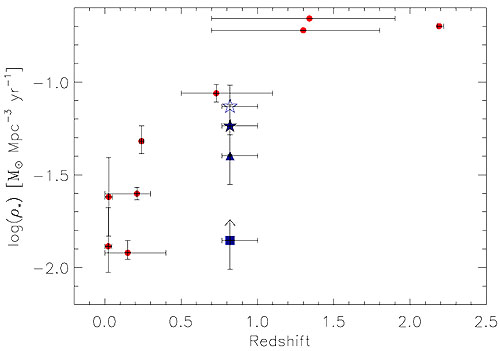 | |||
|
| Home > Public Information > Scientific Highlights > 2006 > The Star Formation Rate at Redshift One |
|
The Star Formation Rate at Redshift One | ||
|
WHT+CIRPASS
The quest for giving the first global view of the history of star formation in the Universe, as a key element in understanding galaxy assembly, commenced around 10 years ago. To date, many quantitative attempts to measure the global star formation history have been based on optical measurements and have thus suffered from having to use different indicators of star formation in various redshift bins, redshifted into the optical. These various indicators not only have uncertain relative calibration but are also affected differently by dust extinction. Commonly used star formation rate (SFR) indicators are ultraviolet (UV) continuum luminosity, which can be heavily dust extincted, and nebular emission lines such as Hα and [O II] (the latter of which is strongly dependent on metallicity and ionization state). Longer wavelength estimators relying on far-infrared (FIR) or radio luminosity are insensitive to dust obscuration and yet have their own caveats. The Universe at redshift z~1–2 is believed to be one of the most active epochs in galaxy formation and evolution. Indeed, it is inferred to be the epoch at which large elliptical and spiral galaxies are assembled and therefore may also be the period of peak star formation in the Universe. Yet, the Universe at this epoch is still neither well studied nor well understood. Observations have long been hampered by the difficulties of observing objects at these redshifts in the visible wavebands. At redshift z~1, key diagnostic spectral features are redshifted out of the optical into the near-infrared (near-IR), which is a difficult regime to work in, and the rest-UV Lyman α line is not accessible in the optical until around redshifts z~2.5. The redshift range z~1–2 has hence traditionally been dubbed the spectroscopic 'redshift desert'. Furthermore, there is certainly evidence that the SFR was much higher in the recent past (z~0.5), compared to the current epoch. However, it is still unclear whether at redshifts of one and beyond the star formation density plateaus, or declines or perhaps continues to increase. A team of astronomers have used the Cambridge Infrared Panoramic Survey Spectrograph (CIRPASS) mounted on the WHT with the aim of addressing the true star formation history of the Universe at redshifts z= 0.7–1.5 , through Hα measurements of a large sample of galaxies. CIRPASS is a near-IR fibre-fed spectrograph operating between 0.9 and 1.67 μm and it can operate with 150 fibres with the ability to simultaneously observe up to 75 targets (in object/sky pairs). CIRPASS work with one of two modes – with an Integral Field Unit or in multi-object mode (CIRPASS-MOS). CIRPASS-MOS was used at the Cassegrain focus of the WHT to observe 62 objects at a time in the Hubble Deep Field-North. The fibre size corresponds to ~1.1 arcsec at the WHT (which is approximately comparable to the expected seeing convolved with typical galaxy profiles, at least for compact galaxies). CIRPASS-MOS demonstrates a powerful new technique for studying distant galaxies, and this is the first successful example of near-IR multi-object spectroscopy of high-redshift galaxies. Stacking the spectra in the rest frame to infer a total SFR for the field, they find a lower limit (uncorrected for dust reddening) on the SFR density at redshift z= 1 of 0.04 solar masses per year and Mpc-3. This implies rapid evolution in the SFR density from z=0 to 1 which is proportional to (1+z)3.1.
This successful application of multi-object fibre spectroscopy to observe high-redshift galaxies constitutes a powerful technique and the success of this multi-object spectroscopic survey bodes well for larger surveys with future instruments such as EMIR on Gran Telescopio Canarias. References:
|
| Top | Back |
|


